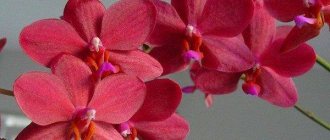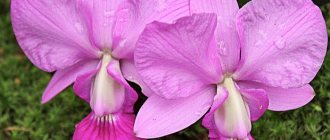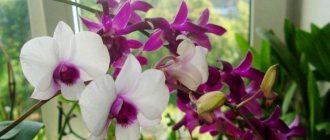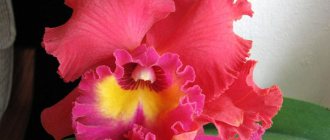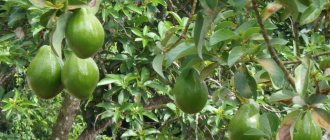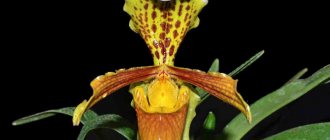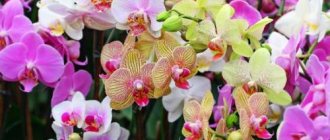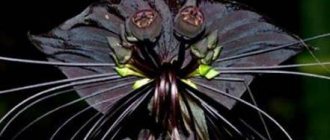- Epiphytes - living on trees with an open root system. Many consider them to be parasitic opportunists, but this is a mistaken belief. Orchids use trees only for support, along which they climb higher towards the sun, clinging to cracks in the bark. The phalaenopsis orchid, popular in indoor floriculture, also leads an epiphytic lifestyle in nature.
Epiphytes
- Terrestrial orchids are those that grow on the forest floor, on moss at the foot of trunks, that is, traditionally burying their roots in the soil.
Terrestrial orchids
- Lithophytes are rock-climbing orchids that miraculously stay on mountain ledges, which are located on rocky plateaus exposed to gusty winds and rains. Of these, xylophytes are distinguished - orchids that have chosen the limestone slopes of the mountains as their home. Once in home conditions, they require the inclusion of calcium in the substrate in the form of crushed eggshells or dolomite flour.
Lithophytes
Among the xylophytes there are many slippers, dendrobiums, and other terrestrial and lithophytic orchids, the most famous of which are:
- dendrobium phalaenopsis (D. phalaenopsis) - found on the island of Larat, located southwest of the island of Java, on limestone cliffs along the entire coast;
D. phalaenopsis
- Paphiopedilum - Haynalda (P. haynaldianum) grows on calcareous hills covered with moss; Stonea (P. stonei) is native to the northern rocky outskirts of the island of Kalimantan; Fowlie (P. fowliei) - lives in the natural environment of the Philippines near the southeastern edge of the island of Palawan on limestone slopes in deciduous litter; single-colored (P. concolor) is distributed in Thailand, Laos, Cambodia, Southwestern China and Northern Vietnam on the ocean shore and along streams on limestone; Rothschild's (P. rothschildianum) is found only in northern Borneo.
P. haynaldianum
How an orchid grows in nature
The orchid is a fairly common plant, with up to 35,000 varieties. The culture is widespread almost all over the world: it is found on every continent in temperate and tropical latitudes. However, most of it is concentrated in the tropics, since the most favorable conditions for development are provided.
Orchids require high temperatures and high humidity. They reproduce and grow naturally. The roots hang from surfaces in large bunches. A peduncle always grows near the leaf rosette; plant seeds or flowers are placed on it.
Goodyear repens
Goodyear creeping is a very rare plant that is found in pine forests among mosses. The leaves of the plant are collected in a rosette and look very much like plantain foliage. But at the same time they are much smaller and decorated with a mesh pattern. Goodyear also belongs to the orchid family. It blooms in mid-summer. The stem grows from a rosette, its height is 15-20 centimeters. And the top is decorated with white flowers. By the end of summer, seeds ripen in small boxes of the plant. They are so small that they are not even visible to the naked eye.
Unlike other plants, they consist of homogeneous tissue, and there are no root primordia or leaves in them. Goodyear has long creeping rhizomes, the surface of which is covered with a dense layer of mushroom threads. Thanks to them, the plant absorbs moisture from the soil. Such close cooperation between plant and fungi is called symbiosis. Gudera cannot grow without mycorrhiza. Even the seeds of a plant will never take root without a fungus. Due to the fact that working with our forest orchids is very difficult, they have practically not been touched by the hands of breeders, so they live the way nature created them millions of years ago.
Parts of the world where orchids grow
Let's look at the most common habitats of orchids.
South Africa and Central America
These regions experience heat and high humidity. The root system does not dry out because it is saturated with water from the air. Such climatic conditions are ideal for the growth of Dendrobium orchids, the representatives of which are striking in their variety of colors.
Mountains of Brazil and Andes, southeast Asia
Compared to the tropics, lower temperatures prevail here. But the orchids managed to take root in such conditions thanks to good lighting and high humidity. Almost all representatives of orchids live in these regions.
The Cattleya variety, growing up to 150 cm, has adapted well to low-temperature conditions.
Plateaus and steppes
Here the climate is not as favorable as in the tropics, so local crops had to adapt to growing in the ground. Orchids also changed their appearance due to sudden changes in daily temperatures.
The most commonly found orchid in these regions is the Orchis orchid, which is decorated with many purple flowers.
Temperate zones
Finding an orchid here is very rare. There are only those species that can grow in the ground. However, in Thailand, orchids grow almost everywhere.
Orchids and man
The ancient Greek scientist Theophrastus called the orchis with paired thickened tubers “orchid,” which means “testicle-like.” The name stuck and was transferred to the entire botanical family. Exotics from Asia and South America conquered England at the beginning of the 19th century.
According to legend, gardener William Cattley planted a strange epiphytic plant in a tub and observed the appearance of large fragrant flowers on the shoots. In honor of the man who discovered wild orchids to Europeans, the Latin name of the genus Cattleya appeared. Cattleya labiata is the national flower of Brazil and is also revered in other South American countries. For its beauty and fragrance, cattleya is sometimes called the “queen of orchids.”
Classification of wild orchids
Saprophytes
Noticeably different from the orchids we are used to. This variety grows underground. It has no leaves at all, only white thickened roots. Externally, saprophytic orchids resemble corals.
The thin trunk of this species is covered with scales. The flowers do not attract attention, they are small, but they exude a pleasant, pronounced aroma.
Saprophytes easily survive for long periods of time without sunlight and are capable of parasitizing other crops.
Epiphytes
Their main difference is the presence of a powerfully developed root system, which is involved in the process of photosynthesis. The most common species for home cultivation - Phalaenopsis and Vanda - are epiphytes. Thanks to aerial roots, epiphytic crops can freely adhere to vertical surfaces - on stones and trees. At the same time, the plant does not cause any harm to the tree.
The variety of colors of the petals makes epiphytes most attractive to insects, which facilitates propagation by seeds. The seed remains viable for 24 months, since even in optimal conditions it is difficult to find the ideal place for the sprout. Epiphytes can bloom all year round.
Methods for propagating dendrobium orchids at home
Terrestrial species
Characterized by a traditional root system. Suitable for growing in temperate climate zones. Roots and green shoots go deep into the soil, which should be well enriched with oxygen.
When the root system grows, the ground orchid resembles a huge bush. Water accumulates in powerful shoots and pseudobulbs. Under unfavorable conditions, the crop sheds some of its leaves.
What types and colors of wild plants are there?
Orchids are a numerous botanical species. No one can say with certainty how many varieties of these magnificent plants exist on Earth. Today, botanists count about 30,000 species. But there are also hybrids. In their natural environment, exotics are pollinated by other flowers, which means they are continuously modified. Because wild specimens spread with astonishing speed, their numbers increase every year.
Varieties of orchids
There are 3 varieties of orchids depending on their method of growth.
Saprophytes
Such plants do not have chlorophyll and leaves. But there is an escape. True, there is only one, but covered with scales. It ends with a flower brush. Saprophytes provide themselves with food by extracting nutrients from humus.
The shape of the roots of such orchids resembles coral. New root shoots do not form in saprophytes - plants absorb water from the substrate with their entire surface.
Epiphytes
The most numerous species live mainly in the tropics. Epiphyte orchids choose trees as their home.
For a long time, people unfairly called the orchid a plant that parasitizes trees, and therefore takes away their vitality. And only recently these exotics were able to regain their good name - it turned out that epiphytes simply cling to wood, using it as a support. At the same time, the trees simply do not notice the natural decorations that have settled on them.
After all, the thin stems of the plant do not know how to stay upright on their own. Unique aerial roots can attach to almost any surface. It is with their help that wild epiphytes absorb moisture from the environment (rain, dew). Also, such plants are able to store moisture in tubers or leaves.
It was epiphytic orchids that people at one time tamed and were able to grow in apartments.
Ground flowers
This species is represented by bulbous flowers with dense green leaves. In America and Europe, they grow to a length of about 50 cm. Tropical exotics form tall, spreading bushes with many inflorescences. Terrestrial specimens are not at all similar to those of their fellows that were domesticated by humans.
The terrestrial wild orchid is a unique representative of its family, an exception to the rule, capable of living in temperate latitudes. Regions with such a climate are characterized by seasonal changes. This means that terrestrial exotics differ from other species in their developmental features. During the warm season, the plant forms root cones underground. They tolerate winter well. In spring, new shoots appear from this part of the plant.
Variety of colors
Wild orchids are striking in their richness of color - these plants can be two-colored, patterned or plain. The only color that nature did not paint these flowers is blue . It is very rare to find plain purple orchids - they are almost always combined with white, orange and yellow.
Black orchids do not exist in nature. Plants lack the gene responsible for this pigment.
Of course, modern breeders have learned to add colors to any flower, even blue or black. For example, Japanese scientists have created a unique blue orchid. However, such shades are not natural for these colors.
Vivid photographs show stunning wild exotics.
Variety of colors
Due to the diversity of species, it is difficult to say with accuracy how many colors the Orchid family has in nature.
We can definitely say that there are buds of all primary colors and their shades.
Orchis spotted
Another forest orchid is the spotted orchis. This species is the most common representative of the orchid family. There are about 24 varieties of orchis growing in Russia. They all differ in the color of flowers, foliage, and the structure of the root system.
The most common species are: spotted orchis. The perennial plant can be seen in forests at the end of June or in July, during its flowering period. Orchis prefers wet glades, forest swamps and shrubs. It is very beautiful during the flowering period. A description of the spotted orchis would be incomplete without talking about its white or light purple flowers. Which are collected in ears. The leaves of the plant have light gray spots, which is where its name comes from. Flowers secrete nectar, which attracts insects that pollinate it, causing the seeds to ripen. Orchis also reproduces only by seeds. The roots of the plant look like flattened cones. If you dig them up during the flowering period, you will find two tubers, one of which is brown in color, and the second is young and light. It is from this that a young plant emerges the next year.
Orchis has long been used as a remedy. Its roots are valuable. They have incredible nutritional value. For example, for an adult, in the absence of other food, it is enough to eat 40 grams of orchis roots, dried into powder and diluted with water. Other species are also used in folk medicine: helmet orchis (Orchis militaris L.), male orchis (Orchis mascula L.), marsh orchis (Orchis palustris L.) and others... Another name for the species is “Scutellaria”, it emphasizes the shape of the upper flower petal. Therefore, the scientific name of the species is “helmeted orchis” (Orchis militaris L.).
Life cycle
Wild orchids have many varieties, each of which differs not only in appearance, but also in the subtleties of reproduction and development. The one thing that all species have in common is longevity. Under natural conditions, orchids can live up to 80 years (and some species live for more than a century).
REFERENCE! In ancient Japan, orchids were inherited, which once again proves the life span of plants.
First mentions
How ginger grows at home and outdoors
The first mentions of orchids are found in ancient Chinese scrolls. Confucius himself wrote about them, comparing their smell with the words of close friends. In Ancient Greece, the orchid was used to achieve success in love affairs, as well as for various rituals.
For your information! It is known that in the 4th century. BC e. The botanist Theophrastus mentioned these flowers, calling them plants that are used to prepare antidepressants.
There is a legend that in the 2nd century. BC e. The orchid helped the Empress of China give birth to children, which she and her husband had dreamed of for several years. At the same time, the Chinese character for orchid appeared.
Important! Orchid pollen has been found in rocks more than 80 million years old.
in the 1st and 2nd centuries. n. e. Chinese scientists have written many scientific works about the healing properties of these plants. There is also information that in the 2nd century. Mexicans used the flower to prepare national drinks. In subsequent centuries, many books and monographs were written about orchids in different parts of the planet.
Differences from home
It is worth noting that most home orchids are hybrid specimens. No matter how hard botanists tried to create optimal indoor conditions for the wild orchid, no one was able to complete the job. Therefore, we had to resort to the help of breeders.
The next difference is life expectancy. Domestic specimens live a maximum of 10 years. Also, domestic crops, when optimal conditions are created, can bloom all year round, but among wild varieties only a few species are capable of this.
Home orchids also do not need support; they grow vertically. These species usually have larger flowers, but are inferior in number to wild varieties.
Features of orchids of equatorial forests
The color of the petals is varied and presented in many shades:
- from soft white to pink;
- from lemon-yellow to red-brown.
They are also spotted and striped. They also differ in the shape of the petals - there are specimens that look like butterflies, birds, mushrooms, etc. The roots are white or silver. They have a spongy layer on top that absorbs water. The leaves are dense and leathery. Perform a protective function for soft tissues. Pseudobulbs store moisture reserves. Orchids also differ in size - from the smallest to the giant. Some flowers have a diameter of 15-25 cm. This is not uncommon for equatorial forests.
Orchids grow on trees with rough bark
Orchids in this zone live on trees with thick, rough bark. Many species grow in clusters. Pollination occurs with the help of insects. For some of them, especially ants, flowers serve as a home. This interaction does not interfere with the normal development of plants.
Features of growth
Let's look at some of the subtleties of growing orchids in the wild.
Reproduction naturally
Most often, wild orchids reproduce by seed. Seed material is carried by the wind over kilometer distances, so the same varieties can be found in opposite parts of the region. In rare cases, reproduction occurs through the light of the lateral processes.
Why does a flower grow on trees?
Under natural conditions, an orchid needs support for normal development. This is why plants are often found on trees. But only epiphytic specimens grow this way. Plants with a well-developed root system are attached by their roots to the surface of the tree (it is desirable that the bark be rougher, so the adhesion will be more reliable).
Humus and moisture collect in the cracks of the bark, as well as numerous microorganisms on which the epiphytic species of wild orchid feeds. In addition, the tree bark protects from the scorching sun.
REFERENCE! Such species can also be found on rocks and rocks.
What is the difference between indoor plants and wild ones?
You need to understand that indoor plants are always the result of the painstaking work of breeders. Creating conditions as close to natural as possible for growing wild orchids is almost impossible and takes a lot of time.
Many domestic specimens easily live in the ground and are less demanding of environmental conditions.
When and how the plant was first brought to Europe
The plant was brought to Europe in the second half of the 18th century. It was brought by travelers from South America. According to legend, a botanist from Great Britain received a gift from his fellow seeker in the form of a shriveled orchid. He planted it, and the beautiful flowers that appeared later became the beginning of the plant's popularity. However, until the orchid took root in Europe, about a hundred years passed.
Botanists conducted many experiments in greenhouses until they were able to grow the first flower. The orchid quickly became popular; having such a flower at home was considered a sign of luxury, and the demand for it grew rapidly. The popularity of the flowers increased even more when rumors emerged that the orchid was an aphrodisiac. Many people added the tubers of the plant to love drinks and believed in its miraculous power.
Rich collectors were willing to buy plants for huge rewards, so money hunters went into the rainforests and overcame many obstacles to get these precious signs of luxury. However, many were unable to bring flowers safely to Europe, since the long journey often became disastrous for them.
Orchids were loaded by the ton onto ships for profit, and for this reason, many species of plants died during the orchid fever. Over time, a greenhouse suitcase was invented that let in light, moisture and protected from direct sunlight. However, while some were hunting, others were looking for ways to domesticate the Orchid family. And already in the 19th century. botanists began to experimentally grow new varieties.
Orchids in nature - photo gallery
A wild orchid differs from a domestic one both in appearance and in its growth characteristics.
There are many species of the Orchid family found in nature, so even botanists still cannot name the exact number.
Orchid blossom is an unforgettable sight
The unusual shape and unique coloring of the petals, spur, and perianth are all necessary to attract pollinators. The “lip” of orchids is a kind of “landing platform” onto which insects descend. The deeper a small animal climbs for nectar in the spur, the more plant pollen collects on the limbs, head and bristles of the body.
The structure of a flower in the form of a trap, the skillful repetition of the appearance of a female insect - only part of the tricks that plants resort to to deceive their pollinators. A wild orchid, a flower familiar to many inhabitants of the northern continents, is Lyubka bifolia. The flower arrow does not appear on this plant every year. Lyubka rests for one season after six years of seed production.

